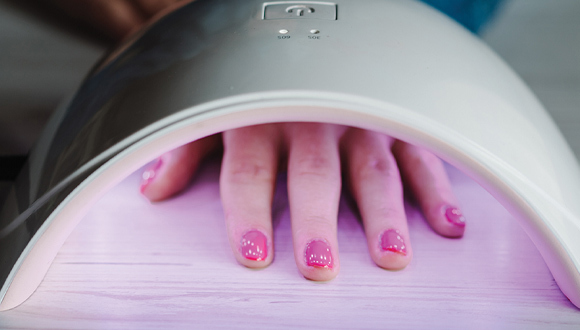After spending $25 on a manicure, there's almost nothing worse than your polish chipping off after just a few days.
If you get your nails done frequently, it's a dilemma you're probably all too familiar with — right up there with having immediate regrets about the polish color you chose.
It's why you've either already switched to gel manicures or are considering doing so.
Gel nail polish results in a much more durable manicure that stays shinier, brighter and chip-free for several weeks, rather than a few days.
But since gel polish can take a manicure from "chips easily" to borderline indestructible, you may be wondering if it damages your nails in the process.
Will gel nails ruin your nails?
A gel manicure includes several of the same basic steps as a traditional manicure, including nail buffing, cuticle tidying and the general use of nail polish.
But there are several key differences to consider.
A few affect your nails and overall health more than you might think.
Curing gel nails always requires harmful UV light
Gel nail polish is thick, so much so that it doesn't actually dry naturally like regular nail polish. Instead, UV light emitted by either an LED dryer or UV lamp is used to dry, or cure, the polish onto your nail.
Exposure to UV light — whether it's from the sun, a tanning bed or a nail salon's dryer lamp — can be dangerous over time, causing DNA damage that can lead to skin cancer and wrinkles.
If you're getting a gel manicure, be sure to protect your skin from the harmful UV light required to cure this polish.
The most effective way to do so is to wear fingertipless UVA-blocking gloves (available for purchase). You can also apply broad spectrum water resistant sunscreen — just be aware that the effectiveness of this sunscreen may be compromised during the nail wash and prep process, particularly if acetone is used.
Lastly, don't get caught thinking that the newer LED dryers some salons use are safer than UV lamps. These LED dryer lamps don't use the same LED bulbs you use around your home. Instead, they use high intensity UVA light to cure gel polish and should be approached with just as much caution as a UV lamp.
Removing gel polish can result in nail damage
In a perfect world, your gel polish is applied and cured perfectly, you don't pick at it whatsoever and, eventually, it's "gently" removed using an acetone soak-off process.
The most obvious snag in this fairy tale story, however, is that you might be someone who can't help but pick at your polish, especially once the color starts to chip off. But there's also the reality that more aggressive removal techniques are sometimes used (and may even be required) to remove gel polish.
To help reduce your risk of nail damage, resist the urge to pick at your gel nails. And when it's time to remove your polish, just be sure that either you or the salon technician you choose knows exactly what to do.
While some very gentle filing may be needed at first to help break down the outermost coat of the gel, avoid using a nail file to manually remove gel polish, as this can result in some serious damage to your nail plate.
Instead, place acetone-soaked cotton balls on your nails, cover each with foil and wait between 10 and 15 minutes. After this soak, the gel polish should float off your nails — with only very light poking and prodding needed.
If this doesn't work, it unfortunately means that your gel polish was over-cured, and more aggressive techniques (that is, filing tools) may be required to remove it. This is why it's so important to find a nail technician experienced in applying and removing gel nails.
Gel manicures may lead to nail weakness, brittleness, and thinning over time
Admittedly, the research is sparse. But it's there.
Studies show that, over time, gel polish and its removal with acetone or manual peeling can weaken your nails, contributing to nail dehydration and thinning of the nail plate. Essentially, the process is tough on your nails.
Quick disclaimer: While an acetone-soak is considered the most "gentle" way to remove gel nails, just keep in mind that this chemical isn't actually gentle.
Does all of this mean you should never get a gel manicure? Probably not.
But it's a good reminder that a gel manicure should be a novelty you treat yourself to occasionally, not the norm. Between manicures, be sure to give your nails plenty of time to recover and rehydrate.
One last thing: shaping and trimming your cuticles isn't great for your nails either
Neatening up your cuticles isn't unique to gel manicures, but it's worth mentioning that pushing or cutting your cuticles can lead to nail damage, inflammation and potentially even infection.
Sure, it makes for a cleaner manicure, but consider asking your nail tech to skip this step next time.


